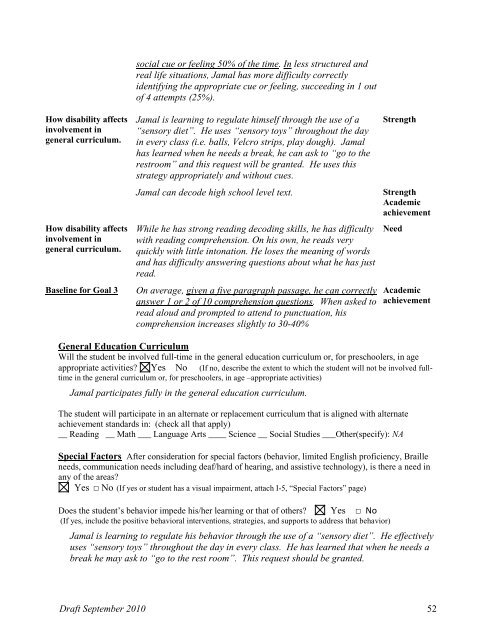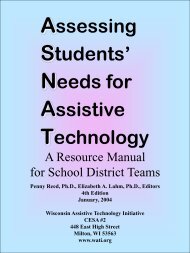Guide for Writing IEPs - The Special Education Team - Wisconsin.gov
Guide for Writing IEPs - The Special Education Team - Wisconsin.gov
Guide for Writing IEPs - The Special Education Team - Wisconsin.gov
Create successful ePaper yourself
Turn your PDF publications into a flip-book with our unique Google optimized e-Paper software.
How disability affects<br />
involvement in<br />
general curriculum.<br />
How disability affects<br />
involvement in<br />
general curriculum.<br />
Baseline <strong>for</strong> Goal 3<br />
social cue or feeling 50% of the time. In less structured and<br />
real life situations, Jamal has more difficulty correctly<br />
identifying the appropriate cue or feeling, succeeding in 1 out<br />
of 4 attempts (25%).<br />
Jamal is learning to regulate himself through the use of a<br />
“sensory diet”. He uses “sensory toys” throughout the day<br />
in every class (i.e. balls, Velcro strips, play dough). Jamal<br />
has learned when he needs a break, he can ask to “go to the<br />
restroom” and this request will be granted. He uses this<br />
strategy appropriately and without cues.<br />
Strength<br />
Jamal can decode high school level text. Strength<br />
Academic<br />
achievement<br />
While he has strong reading decoding skills, he has difficulty<br />
with reading comprehension. On his own, he reads very<br />
quickly with little intonation. He loses the meaning of words<br />
and has difficulty answering questions about what he has just<br />
read.<br />
On average, given a five paragraph passage, he can correctly<br />
answer 1 or 2 of 10 comprehension questions. When asked to<br />
read aloud and prompted to attend to punctuation, his<br />
comprehension increases slightly to 30-40%<br />
Need<br />
Academic<br />
achievement<br />
General <strong>Education</strong> Curriculum<br />
Will the student be involved full-time in the general education curriculum or, <strong>for</strong> preschoolers, in age<br />
appropriate activities? Yes No (If no, describe the extent to which the student will not be involved fulltime<br />
in the general curriculum or, <strong>for</strong> preschoolers, in age –appropriate activities)<br />
Jamal participates fully in the general education curriculum.<br />
<strong>The</strong> student will participate in an alternate or replacement curriculum that is aligned with alternate<br />
achievement standards in: (check all that apply)<br />
__ Reading __ Math ___ Language Arts ____ Science __ Social Studies ___Other(specify): NA<br />
<strong>Special</strong> Factors After consideration <strong>for</strong> special factors (behavior, limited English proficiency, Braille<br />
needs, communication needs including deaf/hard of hearing, and assistive technology), is there a need in<br />
any of the areas?<br />
Yes □ No (If yes or student has a visual impairment, attach I-5, “<strong>Special</strong> Factors” page)<br />
Does the student’s behavior impede his/her learning or that of others? Yes □ No<br />
(If yes, include the positive behavioral interventions, strategies, and supports to address that behavior)<br />
Jamal is learning to regulate his behavior through the use of a “sensory diet”. He effectively<br />
uses “sensory toys” throughout the day in every class. He has learned that when he needs a<br />
break he may ask to “go to the rest room”. This request should be granted.<br />
Draft September 2010 52











